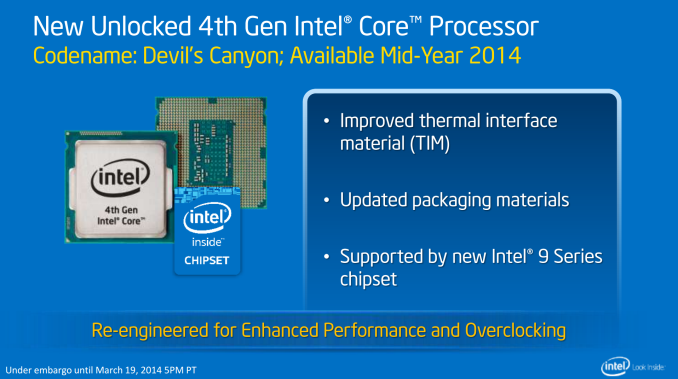
Original Link: https://www.anandtech.com/show/7873/new-haswell-k-overclocking-enhancements
Intel 2014 Enthusiast Processors: New Haswell K with Overclocking Enhancements
by Ian Cutress on March 19, 2014 8:00 PM EST
Rewind back to the launch of Intel’s 3rd generation processor, Ivy Bridge. Enthusiasts and gamers who overclock the top end model were a little disappointed with the maximum CPU frequency that could be achieved. What used to be a 5.0-5.2 GHz ceiling on Sandy Bridge became 4.8-5.0 GHz on Ivy Bridge, and there was more of a silicon lottery as to whether the user got a good overclocking chip or not. Then move forward to Haswell, and the situation compounded in a similar way. 4.6 GHz to 4.8 GHz became the norm on Haswell, a 200 MHz drop which absorbed any IPC increase the new architecture had.
One of the reasons that enthusiasts attributed to this decrease in overclocking was the thermal interface material between the die on the package and the heatspreader. Various experiments by enthusiasts with removing the heatspreader and replacing the TIM inside the CPU to provide better contact and heat transfer characteristics. The adventurous users even used metallic binding material, but the benefits were published for all to see – depending on how good (or bad) the CPU was in the first place, up to a 20ºC drop was seen for overclocked processors at full load.
As part of the Intel press conference call this week, it was announced that a new Haswell processor will come to market to help adjust some of these issues. This new processor will be a fully unlocked Haswell core, codename ‘Devil’s Canyon’ and should be out mid-year (note, Computex is in June). The features that Intel is promoting are the improved thermal interface material, an updated packaging and 9-series chipset support.
‘Improved TIM’ is a little ambiguous – whether this means a more substantial amount of goop under the heatspreader or a proper metalling binding to the heatspreader I do not know, although I have asked Intel. Updated packaging could lead to a thicker/thinner heatspreader, focusing more on the hot areas of the die, or a different binding agent between the PCB and the heatspreader. It may turn out easier to remove the heatspreader if needed, or harder. The final comment had me a little confused, saying 9-series support but not saying anything about the 8-series. I would assume that as a Haswell processor this new SKU would have 8-series support, although Intel have told us that this new CPU is not targeted at 8-series.
There is no word if this is going to be placed at the same frequency as the i7-4770K or the i7-4771/4790, the name or the rated TDP. Intel will let us know nearer to release, and as soon as we get this information and are able to share with you, we will.







